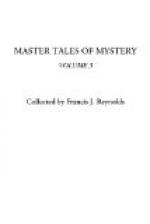Quickly he led the way up the handsome staircase and into a large, lofty, richly furnished room. Everywhere there were thick, heavy carpets on the floors, into which your feet sank with an air of satisfying luxury.
The room into which we entered was indeed absolutely windowless. It was a room built within the original room of the old house. Thus the windows overlooking the street from the second floor in reality bore no relation to it. For light it depended on a complete oval of lights overhead so arranged as to be themselves invisible, but shining through richly stained glass and conveying the illusion of a slightly clouded noon-day. The absence of windows was made up for, as I learned later, by a ventilating device so perfect that, although everyone was smoking, a most fastidious person could scarcely have been offended by the odor of tobacco.
Of course I did not notice all this at first. What I did notice, however, was a faro-layout and a hazard-board, but as no one was playing at either, my eye quickly traveled to a roulette-table which stretched along the middle of the room. Some ten or a dozen men in evening clothes were gathered watching with intent faces the spinning wheel. There was no money on the table, nothing but piles of chips of various denominations. Another thing that surprised me as I looked was that the tense look on the faces of the players was anything but the feverish, haggard gaze I had expected. In fact, they were sleek, well-fed, typical prosperous New-Yorkers rather inclined to the noticeable in dress and carrying their avoirdupois as if life was an easy game with them. Most of them evidently belonged to the financial and society classes. There were no tragedies; the tragedies were elsewhere—in their offices, homes, in the courts, anywhere, but not here at the club. Here all was life, light, and laughter.
For the benefit of those not acquainted with the roulette-wheel—and I may as well confess that most of my own knowledge was gained in that one crowded evening—I may say that it consists, briefly, of a wooden disc very nicely balanced and turning in the center of a cavity set into a table like a circular wash-basin, with an outer rim turned slightly inward. The “croupier” revolves the wheel to the right. With a quick motion of his middle finger he flicks a marble, usually of ivory, to the left. At the Vesper Club, always up-to-date, the ball was of platinum, not of ivory. The disc with its sloping sides is provided with a number of brass rods, some perpendicular, some horizontal. As the ball and the wheel lose momentum the ball strikes against the rods and finally is deflected into one of the many little pockets or stalls facing the rim of the wheel.
There are thirty-eight of these pockets; two are marked “0” and “00,” the other numbered from one to thirty-six in an irregular and confusing order and painted alternately red and black. At each end of the table are thirty-six large squares correspondingly numbered and colored. The “0” and “00” are of a neutral color. Whenever the ball falls in the “0” or “00” the bank takes the stakes, or sweeps the board. The Monte Carlo wheel has only one “0,” while the typical American has two, and the Chinese has four.




